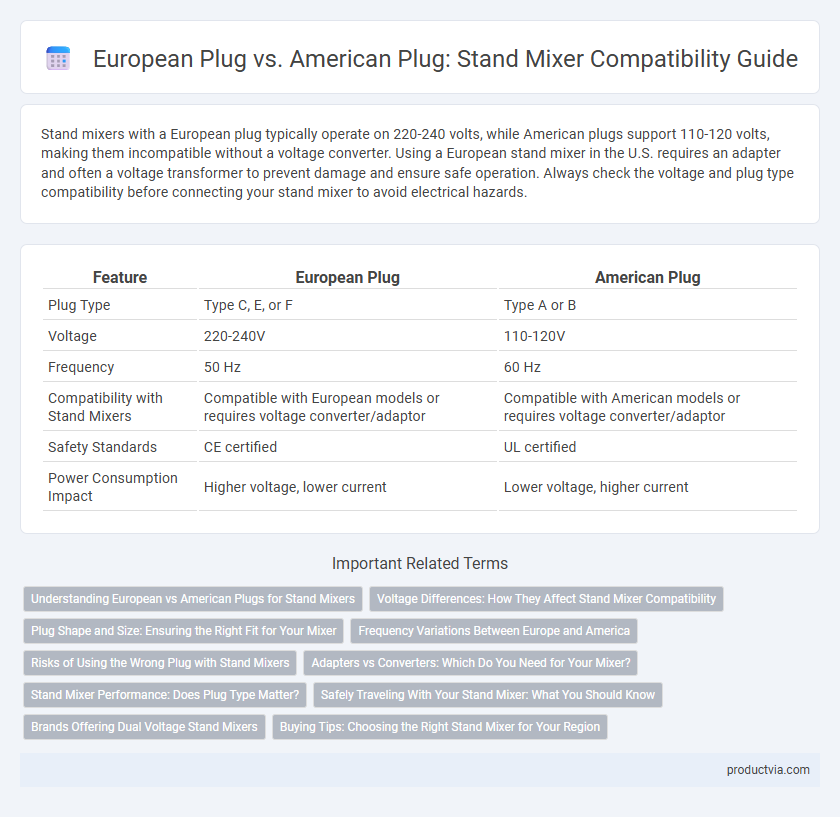Stand mixers with a European plug typically operate on 220-240 volts, while American plugs support 110-120 volts, making them incompatible without a voltage converter. Using a European stand mixer in the U.S. requires an adapter and often a voltage transformer to prevent damage and ensure safe operation. Always check the voltage and plug type compatibility before connecting your stand mixer to avoid electrical hazards.
Table of Comparison
| Feature | European Plug | American Plug |
|---|---|---|
| Plug Type | Type C, E, or F | Type A or B |
| Voltage | 220-240V | 110-120V |
| Frequency | 50 Hz | 60 Hz |
| Compatibility with Stand Mixers | Compatible with European models or requires voltage converter/adaptor | Compatible with American models or requires voltage converter/adaptor |
| Safety Standards | CE certified | UL certified |
| Power Consumption Impact | Higher voltage, lower current | Lower voltage, higher current |
Understanding European vs American Plugs for Stand Mixers
European stand mixers typically use Type C or Type F plugs with 230V voltage and 50Hz frequency, while American stand mixers use Type A or Type B plugs with 120V voltage and 60Hz frequency. This voltage and plug design difference requires the use of appropriate voltage converters or plug adapters to ensure safe and efficient operation of stand mixers across regions. Understanding these electrical specifications is critical to avoid damaging the mixer or causing electrical hazards when using a European stand mixer in the U.S. or vice versa.
Voltage Differences: How They Affect Stand Mixer Compatibility
European plugs typically operate on 220-240 volts, while American plugs use 110-120 volts, creating a significant voltage difference that directly impacts stand mixer compatibility. Using a European stand mixer with an American plug without a proper voltage converter can result in underperformance or damage due to insufficient voltage. Selecting a stand mixer compatible with the local voltage or utilizing a reliable step-up transformer is essential for safe and efficient operation.
Plug Shape and Size: Ensuring the Right Fit for Your Mixer
European plugs typically have two round prongs spaced 19 mm apart, while American plugs feature two flat parallel blades with an optional grounding pin, making their shapes and sizes incompatible without an adapter. Ensuring the right fit for your stand mixer requires verifying the plug type matches your region's outlet to avoid connection issues or damage. Using a compatible adapter or converter can facilitate proper connection, but checking voltage compatibility remains essential for safe operation.
Frequency Variations Between Europe and America
European stand mixers typically operate at 50 Hz frequency, while American mixers are designed for 60 Hz, affecting motor speed and performance. Using a stand mixer with the incorrect frequency can lead to inefficient operation, overheating, or reduced lifespan of the appliance. Ensuring compatibility between the stand mixer's frequency rating and the local power supply is crucial for optimal functionality and safety.
Risks of Using the Wrong Plug with Stand Mixers
Using the wrong plug for a stand mixer can cause severe electrical hazards, including short circuits and potential fire risks due to voltage mismatches between European (220-240V) and American (110-120V) systems. This incompatibility can damage the mixer's motor, void warranties, and lead to costly repairs or replacements. Ensuring the correct plug and voltage compatibility is crucial to maintain appliance safety and optimal performance.
Adapters vs Converters: Which Do You Need for Your Mixer?
When using a stand mixer designed for a European plug in the US, an adapter is sufficient if the voltage matches 120V; however, most European mixers operate at 220-240V, requiring a voltage converter to prevent damage. An adapter only changes the plug shape to fit American outlets, while a converter actively transforms the electrical current to match your mixer's voltage requirements. Ensuring compatibility avoids electrical hazards and maintains the longevity of your stand mixer.
Stand Mixer Performance: Does Plug Type Matter?
Stand mixer performance remains consistent regardless of whether it uses a European plug or an American plug, as the primary factor is voltage compatibility rather than plug shape. European plugs typically supply 220-240 volts, whereas American plugs provide 110-120 volts, so using the appropriate voltage adapter or a model designed for the region ensures optimal motor function and mixing efficiency. Plug type affects connection interface but does not inherently influence the mixing power, torque, or speed of the stand mixer.
Safely Traveling With Your Stand Mixer: What You Should Know
European plugs typically operate at 220-240 volts and have different prong designs compared to American plugs, which use 110-120 volts, making direct compatibility impossible without an adapter or voltage converter. Using a stand mixer with an incompatible plug or voltage can damage the appliance or create electrical hazards, so it is crucial to use a certified step-up or step-down transformer designed for kitchen appliances. When traveling, verify the mixer's voltage rating and invest in high-quality, grounded adapters to ensure safe and reliable operation abroad.
Brands Offering Dual Voltage Stand Mixers
Brands like KitchenAid and Kenwood offer dual voltage stand mixers designed for both European (230V) and American (120V) outlets, ensuring compatibility across regions. These models typically include interchangeable plugs or voltage selectors to accommodate different power standards safely without the need for external adapters. Dual voltage stand mixers enhance convenience for international users, eliminating concerns about electrical compatibility during travel or relocation.
Buying Tips: Choosing the Right Stand Mixer for Your Region
When selecting a stand mixer, it is crucial to consider the plug type and voltage compatibility to avoid electrical issues. European stand mixers typically feature a Type C or Type F plug operating at 220-240V, while American models use a Type A or Type B plug designed for 110-120V. Buyers should ensure their electrical outlets match the mixer's plug and voltage or invest in a reliable voltage converter or plug adapter to maintain safety and device performance.
European plug vs American plug for stand mixer compatibility Infographic

 productvia.com
productvia.com